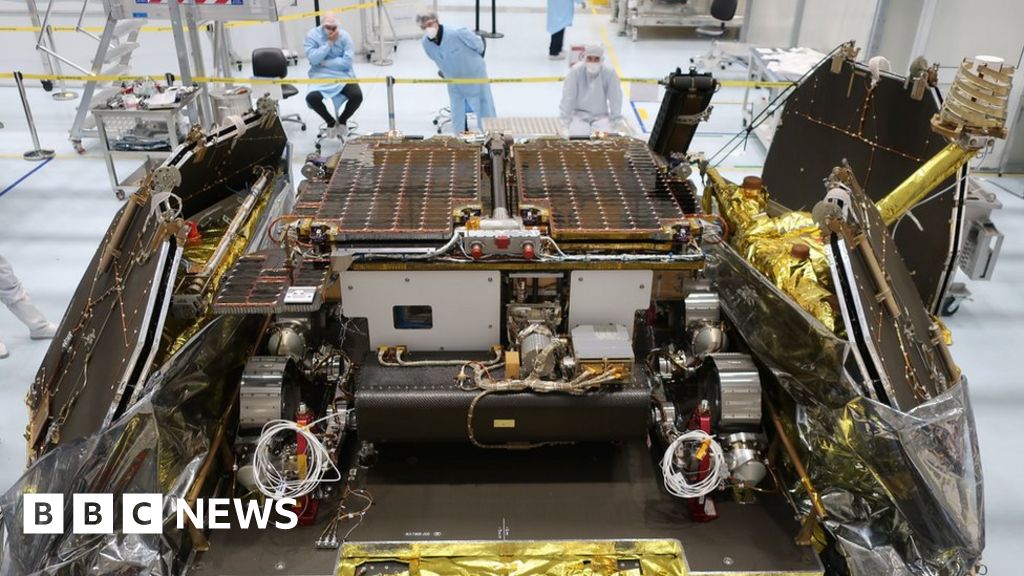![]()
Water on Mars, in the form of brines, may not be as widespread as previously thought, according to a new study by researchers at the Arkansas Center for Space and Planetary Sciences.
Researchers combined data on brine evaporation rates, collected through experiments at the center's Mars simulation chamber, with a global weather circulation model of the planet to create planetwide maps of where brines are most likely to be found.
The scientists took all major phase changes of liquids into account -- freezing, boiling and evaporation -- instead of just a single phase, as has commonly been the approach in the past, said Vincent Chevrier, associate professor and first author of a study published in The Planetary Science Journal . Former U of A doctoral students Edgard G. Rivera-Valentín and Travis S. Altheide were coauthors of the paper.
In case you are keeping track:
Heat and Dust Help Launch Martian Water Into Space, Scientists Find | NASA
'Mars, here we come!' SpaceX wows with Starship's most daring (and explosive) test flight yet
:strip_exif(true):strip_icc(true):no_upscale(true):quality(65)/d1vhqlrjc8h82r.cloudfront.net/12-10-2020/t_0c011cbbbc7d4d81afab3eb0d26878f0_name_t_922809fdd7e743bc9ea32173b8bed21a_name_image.jpg)
The internet collectively picked its jaw up off the floor Wednesday as SpaceX launched a prototype of its Starship spaceship from Texas, performing an aerial wonder and then come back down for a fiery landing.
After the first attempt Tuesday was scrubbed at the last second, SpaceX tried again Wednesday to test its latest Starship prototype known as SN8 from the company's Boca, Chica, Texas launch site.
Around 5:40 p.m. ET the shiny towering Starship ascended from the pad, slowly using its three Raptor engines. The goal was to reach around 50,000 feet, the highest yet for any Starship test flight.
Euro-Russian Mars rover mission takes shape - BBC News

.css-14iz86j-BoldText{font-weight:bold;} A key milestone has been reached in the preparations for the joint European and Russian mission to Mars, scheduled for launch from Earth in 2022.
* * *
The UK-assembled robot is seen sitting atop the lander in a folded configuration - as it will be for the journey to, and the touchdown on, Mars.
The capsule's job will be to protect the Franklin robot and Kazachok platform from the searing heat that is encountered on entry into Mars' atmosphere. The cruise module is the vehicle that shepherds the whole mission to the Red Planet after launch.
While you're here, how about this:
Making Mars the new Earth; FGCU researches what it would take

Researchers at Florida Gulf Coast University are working to figure out what it would take for us to call the Red Planet home.
The university’s department of construction management is looking into the type of energy that would be the most effective, and the best types of buildings.
We’ve mapped the entire Earth. Now, space is the final frontier, with NASA working to send astronauts to Mars by the year 2030.
Dr. Hashem Izadi Moud, an assistant professor at FGCU said, “Solar energy is our best bet to actually start construction processes and building houses on the moon or Mars.”
Sols 2965-2966: Meteorite or Meteor-wrong? – NASA's Mars Exploration Program

Curiosity hits the road again today, heading towards the contact with a rubbly-looking geologic unit on the way up Mount Sharp. In the middle of today’s drive, Curiosity will make a pit stop to look at a large, dark, shiny boulder called “Island Davaar” with the Mastcam filter set. The boulder, which is visible in the distance from our current position (it’s in the center of the Navcam image above), does not look like any other rocks in the surrounding landscape.
Before driving, Curiosity will wrap up some science observations from her current location, including APXS and MAHLI observations of the bedrock target “Achnasheen,” ChemCam LIBS observations on two other rock targets (“Rattray” and “White Coomb”), and Mastcam imaging of regions in front of the rover and out towards the horizon.
Water on Mars not as widespread as previously thought, study finds | EurekAlert! Science News

IMAGE: Researcher Rachel Slank works with the university's Mars chamber. view more
* * *
FAYETTEVILLE, Ark. - Water on Mars, in the form of brines, may not be as widespread as previously thought, according to a new study by researchers at the Arkansas Center for Space and Planetary Sciences.
Researchers combined data on brine evaporation rates, collected through experiments at the center's Mars simulation chamber, with a global weather circulation model of the planet to create planetwide maps of where brines are most likely to be found.

No comments:
Post a Comment